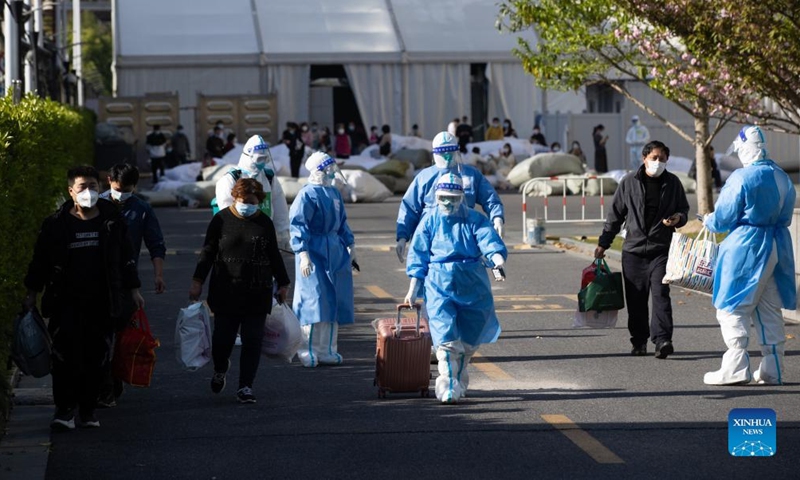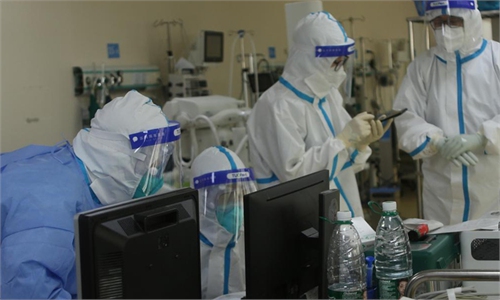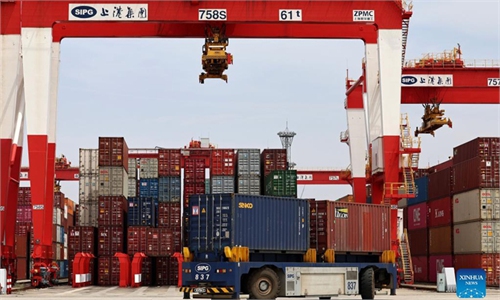Shanghai vows to continue decisive battle against epidemic, stick to dynamic zero-COVID policy after CPC top leadership meeting

Patients who have recovered from COVID-19 leave a makeshift hospital converted from Shanghai Convention & Exhibition Center of International Sourcing in Shanghai, April 9, 2022. Photo:Xinhua
Shanghai said on Friday that it will continue to push forward the decisive battle against the epidemic and stick to the dynamic zero-COVID policy, after the meeting of the Standing Committee of the Political Bureau of the CPC Central Committee on COVID-19 prevention work was held in Beijing on Thursday.
The city vows to learn and implement the spirit of the meeting and win the battle against the epidemic, according to Shanghai's executive vice mayor Wu Qing at Friday's press briefing.
Shanghai has registered nearly 600,000 local COVID-19 positive cases during the current Omicron outbreak from March 1 to Thursday. The epidemic in Shanghai has been effectively curbed and the situation is stable and improving, Wu said.
Shanghai has kept the Rt value at below 1.0 for more than 10 consecutive days, and has indicated the declining trend of newly reported positive cases for two weeks, according to Shanghai authorities on Friday. Experts noted that an Rt of less than 1.0 means the number of new infections is decreasing.
However, the decline in the number of new positive infections in a single day was relatively small, and there were still reports of positive cases at the community level, indicating the risk of a rebound of the epidemic, Wu said, noting that the task of prevention and control remains arduous in key areas and groups and decisive measures should be continued.
The measures include focusing on old residential areas, urban villages, construction sites, nursing homes and other key places and groups to detect positive cases in a timely manner, and mass screenings of nucleic acid and antigen tests will be continued as well, Wu said.
The communities will continue to be classified as "lockdown," "controlled" and "precaution" with preventive and control measures based on the screening results and risks; epidemiological investigation will be conducted in the first place and positive cases should be transferred and put under quarantine in the first time to curb the communities transmission, according to Wu.
The resources such as designated hospitals, makeshift hospitals, isolation rooms, and nucleic acid sampling and testing will be coordinated and improved. Chinese medicine will be put into use to help groups at high risk.
Residents are not allowed to leave Shanghai unless it's necessary. Residents who need to leave the city will have to provide their negative nucleic acid test and antigen test results as well as their health code, Wu noted.
So far seven districts and some streets in Pudong New Area have achieved the goal of zero-COVID at the community level, according to the authorities on Friday.
The city on Thursday reported 245 local COVID-19 cases and 4,024 local asymptomatic infections.
From May 1 to Thursday, the city has taken 45 million nucleic acid samplings. Over 16.67 million residents were under precaution regions, which means that they could be allowed to move within certain regions at certain times, according to local authorities.
More than 481,000 COVID-19 patients have been discharged from hospitals or released from medical observation, accounting for over 80 percent of the total positive cases among this wave of outbreak, said authorities.
Also, 12 new COVID-19-related deaths were reported on Thursday, with the average age of 84.08, leading to a total number of deaths of 515. Only one of the 12 patients was vaccinated and all their deaths were caused by underlying diseases, Zhao Dandan, deputy director of Shanghai health commission, said at Friday's press briefing.
There are 526 severely ill patients and 95 critically ill patients being treated in hospitals as of Thursday, Zhao noted.


